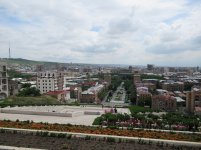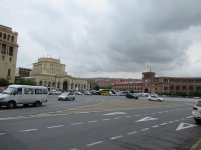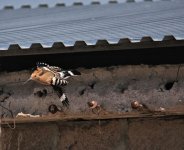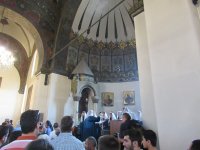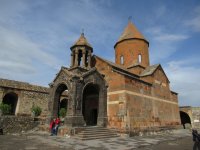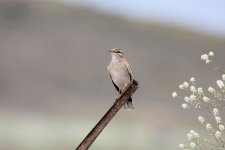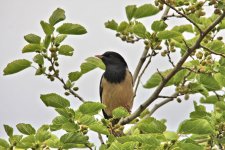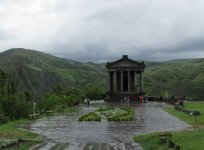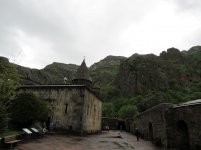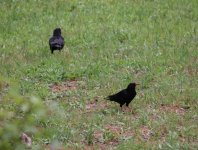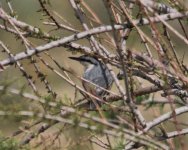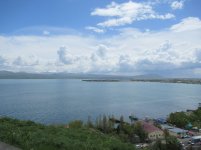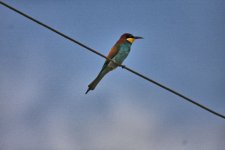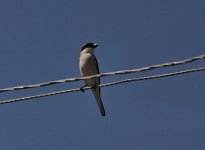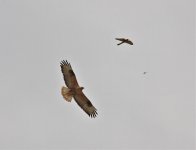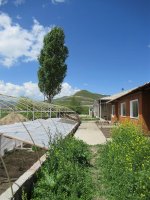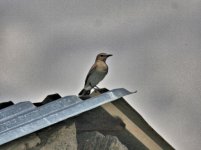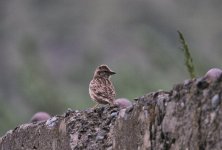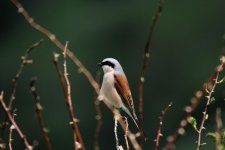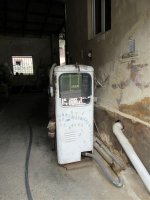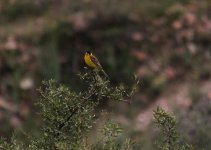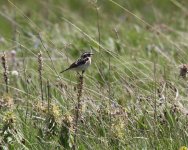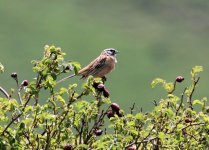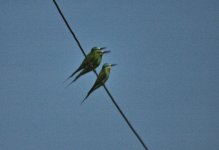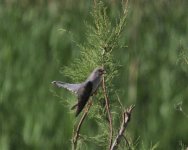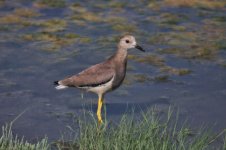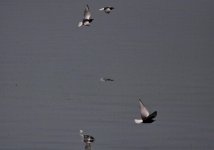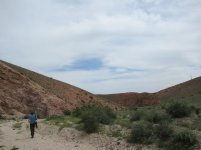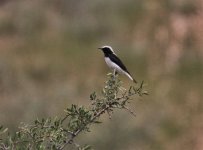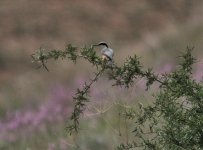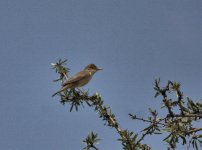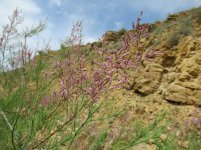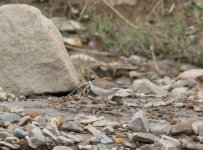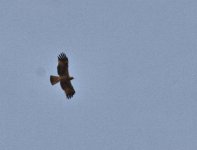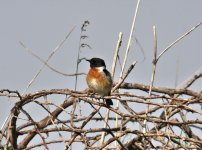Richard Prior
Halfway up an Alp

This was what you might call a hybrid trip for my wife and I, originally planned to consist of one week working and generally helping at a refugee centre for Armenians displaced from Syria in the north of the country with a few other visitors, then a second week of just the two of us travelling around Armenia, visiting a few birdy sites as well as some of the ‘less travelled roads’ of the country. Because we were transporting various essentials for the refugees we weren’t able to take my ‘scope and tripod which cost us a few species (mainly waders at Armash Fish Ponds).
In the end it turned out that some touristy stuff had been organised for the first four days so our time spent ‘being useful’ was somewhat reduced. Six of us were based at a friend’s apartment on a busy street in the centre of the capital, Yerevan for the first four nights, then two nights at the centre in Spitak. The two of us then spent two more nights in Yerevan before we set off to explore (and do some birding!), we stayed two nights in Vayk, and one night each in Tsapatagh (Lake Sevan north shore), Idjevan and Dilijan before returning to Yerevan for our middle of the night flight back.
Although it’s not too difficult to find accommodation on arriving in a town, we had booked our overnight stops before leaving France. Similarly, we booked cars (a huge one for the 1st week and a Lada Niva for the 2nd:eek! with Europcar who now have a desk in arrivals at Yerevan airport as well as in the city centre. This meant we could pick up the first week’s vehicle on our arrival at the airport, change it for the Niva at their city centre office a week later, and drop it off at the airport the night we left to come home, they were very helpful.
with Europcar who now have a desk in arrivals at Yerevan airport as well as in the city centre. This meant we could pick up the first week’s vehicle on our arrival at the airport, change it for the Niva at their city centre office a week later, and drop it off at the airport the night we left to come home, they were very helpful.
After having lived in Lebanon, driving in Armenia was a breeze, speed limits and traffic lights are respected (lots of speed cameras!), though the state of roads apart from the major routes was generally poor, lots of potholes or sudden change from tarmac surface to dirt/stones, especially inside villages.
The cost of food, accommodation and fuel for cars was much cheaper than in Western Europe. We took Euros with us and changed for Armenian drams as and when needed, thus avoiding using bank or credit cards. All the decent sized towns had currency exchange bureaux. Outside of Yerevan we found little English or French was spoken, Russian is the most commonly used second language, we had learnt a little bit of Armenian before the trip, my wife had even learnt how to read the Armenian alphabet which helped when road signs were only in Armenian (though most had the Latin alphabet version of the village/town on them anyway).
We found the Armenian people to be very friendly and hospitable, men are respectful towards women and the crime rate is low. Tourism is very important for the country’s economy, unfortunately Armenia doesn’t have natural gas or oil and most industry collapsed with the end of the Soviet Union, the borders with Turkey and Azerbaijan have been closed since the Nagorno Karabakh dispute in the early 1990s so all land transported goods arrive either through Georgia to the north or via the one border crossing with Iran to the south.
May is known to be the rainiest month of the year and it did indeed rain at some time or other on all but our penultimate day, fortunately never for more than an hour or so though sometimes there were spectacular thunderstorms. Temperatures around Yerevan and the southern plain and wadis were around 24°C when sunny, up around Lake Sevan it was cooler (18°) and obviously at the mountain passes, especially if the wind was blowing.
12 May
After our midnight arrival, it was a leisurely start and late breakfast, followed by a (long) walk around the city’s sights. I had briefly visited Yerevan two and a half years ago, and noticed that a number of the small parks in the city had since been built on, or were in the process of being developed, a shame as these green spaces are part of the charm of the place (plus one of them had breeding Shikra a few years back!). Rook were nesting in our noisy street’s trees which was a surprise, the parks in the centre held Blackbird, Great Tit, House Sparrow and Goldfinch, plenty of Swift screaming around, plus city dwelling Barn Swallow and Hooded Crow. After such a late (and hearty) breakfast we kept going well into the afternoon, eventually stopping for a drink at the top of the Cascade near the monument dating from the 1970s commemorating 50 years of Armenia being a Soviet Union Republic (unlike Lenin’s statue, this monument has rested untouched since Armenia’s independence upon the USSR’s demise). The big park at the top was interesting with Hoopoe, Crag Martin, White Wagtail, Spotted Flycatcher, Greenfinch plus singing Lesser Whitethroat and Common Rosefinch. Jackdaw and Magpie also around. The White Wagtails were of the dukensoiniusis race, with a large white panel on the closed wing. A couple of Spotted Flycatcher were also busy, er, catching flies. I was surprised to see a Peregrine flying around the monument but discovered later that a pair nest in the city.
In the end it turned out that some touristy stuff had been organised for the first four days so our time spent ‘being useful’ was somewhat reduced. Six of us were based at a friend’s apartment on a busy street in the centre of the capital, Yerevan for the first four nights, then two nights at the centre in Spitak. The two of us then spent two more nights in Yerevan before we set off to explore (and do some birding!), we stayed two nights in Vayk, and one night each in Tsapatagh (Lake Sevan north shore), Idjevan and Dilijan before returning to Yerevan for our middle of the night flight back.
Although it’s not too difficult to find accommodation on arriving in a town, we had booked our overnight stops before leaving France. Similarly, we booked cars (a huge one for the 1st week and a Lada Niva for the 2nd:eek!
After having lived in Lebanon, driving in Armenia was a breeze, speed limits and traffic lights are respected (lots of speed cameras!), though the state of roads apart from the major routes was generally poor, lots of potholes or sudden change from tarmac surface to dirt/stones, especially inside villages.
The cost of food, accommodation and fuel for cars was much cheaper than in Western Europe. We took Euros with us and changed for Armenian drams as and when needed, thus avoiding using bank or credit cards. All the decent sized towns had currency exchange bureaux. Outside of Yerevan we found little English or French was spoken, Russian is the most commonly used second language, we had learnt a little bit of Armenian before the trip, my wife had even learnt how to read the Armenian alphabet which helped when road signs were only in Armenian (though most had the Latin alphabet version of the village/town on them anyway).
We found the Armenian people to be very friendly and hospitable, men are respectful towards women and the crime rate is low. Tourism is very important for the country’s economy, unfortunately Armenia doesn’t have natural gas or oil and most industry collapsed with the end of the Soviet Union, the borders with Turkey and Azerbaijan have been closed since the Nagorno Karabakh dispute in the early 1990s so all land transported goods arrive either through Georgia to the north or via the one border crossing with Iran to the south.
May is known to be the rainiest month of the year and it did indeed rain at some time or other on all but our penultimate day, fortunately never for more than an hour or so though sometimes there were spectacular thunderstorms. Temperatures around Yerevan and the southern plain and wadis were around 24°C when sunny, up around Lake Sevan it was cooler (18°) and obviously at the mountain passes, especially if the wind was blowing.
12 May
After our midnight arrival, it was a leisurely start and late breakfast, followed by a (long) walk around the city’s sights. I had briefly visited Yerevan two and a half years ago, and noticed that a number of the small parks in the city had since been built on, or were in the process of being developed, a shame as these green spaces are part of the charm of the place (plus one of them had breeding Shikra a few years back!). Rook were nesting in our noisy street’s trees which was a surprise, the parks in the centre held Blackbird, Great Tit, House Sparrow and Goldfinch, plenty of Swift screaming around, plus city dwelling Barn Swallow and Hooded Crow. After such a late (and hearty) breakfast we kept going well into the afternoon, eventually stopping for a drink at the top of the Cascade near the monument dating from the 1970s commemorating 50 years of Armenia being a Soviet Union Republic (unlike Lenin’s statue, this monument has rested untouched since Armenia’s independence upon the USSR’s demise). The big park at the top was interesting with Hoopoe, Crag Martin, White Wagtail, Spotted Flycatcher, Greenfinch plus singing Lesser Whitethroat and Common Rosefinch. Jackdaw and Magpie also around. The White Wagtails were of the dukensoiniusis race, with a large white panel on the closed wing. A couple of Spotted Flycatcher were also busy, er, catching flies. I was surprised to see a Peregrine flying around the monument but discovered later that a pair nest in the city.




